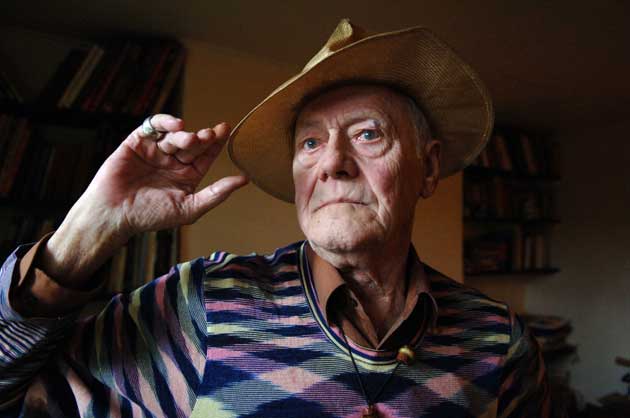Percy Savage: Doyen of fashion PR

Percy Savage, an enigmatic, Zelig-like character, personified the world of fashion and spent a lifetime promoting it. Arriving in Paris from Australia in 1947, the year Christian Dior launched his New Look, Savage became a close friend of the great designer, who was to name Eau Sauvage after him.
Savage recalled, "I was invited to a brainstorming session at Dior's house but unfortunately arrived late. When the butler announced my arrival someone banged on the table and said, 'Oh Savage, always late!' Dior clapped his hands and said, 'That's it! Eau Sauvage'."
It was Savage who recommended that Dior employ the young Yves Saint Laurent. Dior heeded his friend's advice and Saint Laurent went on to become the most celebrated fashion designer in the world. By 1950 Savage had become Lanvin's first Head of Public Relations and his influence was felt throughout fashion. As Mary Quant said in the 2004 documentary A Savage Life in Fashion, "He stood over so much that came from Paris but he's also far more international and joined together influences from all over the world."
Born in Brisbane in 1926, Savage inherited discipline and determination from his father, Major Percival Savage and social flair from his mother, Marjorie Hall. He grew up in Brisbane, before moving to Sydney to study art and continue his ballet training. In Sydney he was a friend of J.C. Williamson, Joan Sutherland, Arthur and David Boyd and Donald Friend. In 1947, he set sail for England on a Commonwealth scholarship to study art and design at the Slade. Finding London cold and grey, and ravaged by war, he lasted two weeks before heading for Paris and a life of salons, art and haute couture.
Graduating from the Sorbonne in history of art, and a regular guest at the salons of high society, Savage embarked on a career designing silk scarves for Dior and Balenciaga. His style, charisma and exotic flair won him all manner of admirers including Jean Cocteau, the Comtesse de Polignac, the Baron de Bosmelet, Cecil Beaton and Michel de Brunhoff, editor of Vogue.
Before long he found himself at Lanvin as chef de publicité. At Lanvin in the 1950s and Nina Ricci in the 1960s, Savage overturned the established order of fashion promotion by circumventing a well-respected law issued by the French Ministry of Culture, which banned fashion houses from advertising their dresses in the media. When Elizabeth Taylor came to Paris for a film premiere in 1954, Savage met her at the Hotel Meurice and gave her a Lanvin dress. After she promised to wear it at the premiere that evening, Savage alerted the press. When they later asked Taylor who had made her dress, she replied, "It's a Lanvin. Isn't it divine?" The publicity was enormous and as a consequence, the ban was dropped.
Savage was the first to see the value of celebrities wearing designer dresses at gala events: what would become a staple of fashion PR. Jackie Kennedy and Farah Dibah were others who wore dresses selected for them by Savage. "PR is vitally important because it costs so much less than advertising," he said. "Advertising has huge budgets whereas you can get the same amount of publicity in The Times or The Telegraph for the price of a couple of good lunches."
In Paris and around the word he courted celebrity and commanded attention. He introduced Mary Quant to the American press, turning her into a global superstar; he hid Nureyev when the Russian dancer defected but at the same time was friends with Khrushchev; he dated Ginger Rogers and Maria Callas after her break-up with Onassis and was given as a gift by Emperor Haile Selassie of Ethiopia two pet cheetahs, which he used to take for walks in the Bois de Boulogne.
At the end of the 1960s, Savage established YSL in London with Clare Rendlesham. By 1970 he had settled in England permanently and at the behest of powerful journalists including Ernestine Carter and Beatrix Miller, Savage set about elevating the profile of British fashion. His years at the forefront of fashion PR boosted the fortunes of, among others, Zandra Rhodes, Bruce Oldfield, Katharine Hamnett, Wendy Dagworthy and Vivienne Westwood. He instituted London Collections, putting on the first group designer show at the Ritz in 1974. With his ambition and foresight he paved the way for London Fashion Week and heralded a glorious era for British designers that led to the likes of Alexander McQueen, Stella McCartney and John Galliano dominating the industry.
In more difficult economic times in the late 1970s, plagued by ambition, an occasional temper and fierce competition, Savage was broken by the game and, finally, bankrupted. Beaten but not bowed, he carried on writing for various publications, mentoring young designers and even modelling.
Savage's happiest days were in Paris, where he lived the most wonderful life. His friend the fashion editor Suzy Menkes recalled their first encounter, "I was very young and shy and new. I remember this creature, this exotic, outlandish creature wearing a black hat of which you could just see the silhouette, talking to a very senior editor and he just summed up for me what it was to be in Paris."
He will be remembered as a generous friend, captivating raconteur and one of the fashion world's true mavericks.
Winston Cuthbert
Donald Percival Savage, public relations executive: born Brisbane, Queensland 12 October 1926; married 1961 Frances Coolahan (one daughter; marriage dissolved 1965), 1977 Alicja Sedniska (died 1983); died London 12 August 2008.
Subscribe to Independent Premium to bookmark this article
Want to bookmark your favourite articles and stories to read or reference later? Start your Independent Premium subscription today.

Join our commenting forum
Join thought-provoking conversations, follow other Independent readers and see their replies